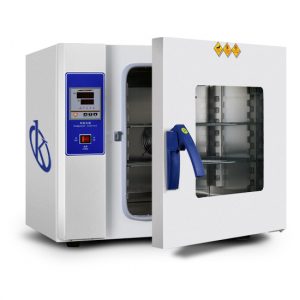Hot air is one of the most widely used dry heat sterilization methods. This process is carried out in ovens, which allow uniform heat distribution inside, where the material is exposed to temperatures of around 170°C for 2 hours. Dry heat sterilization destroys micro-organisms by oxidizing their cellular components. This is a less efficient process than moist heat sterilization, as microorganisms die more rapidly when in the presence of water, as it makes it easier to change their protein configuration, and provides a means of distributing heat evenly throughout the internal chamber of the sterilization equipment. Therefore, to achieve sterilization of the material using dry heat, higher temperatures need to be applied for longer. The sterilization time must be determined for each type of material, e.g. in the case of highly heat-resistant materials, higher temperatures can be used for shorter times.
How is a oven sterilized?
To sterilize using hot air, you need to place the objects in a oven. The air inside is heated to between 150 and 190°C. One of the first devices used for this purpose was the Pasteur oven, which was later replaced by hot-air ovens. These consist of a double chamber, with hot air generated by an electric resistance circulating in the main cavity and in the space between the two chambers, at variable temperatures, the most recommended being 170º C for the metal instrument and 140º C for the drum contents. A stable temperature is maintained by so-called bimetallic thermostats, made of two metals with different coefficients of expansion. When one expands, the other doesn’t, and arches. One end of this device is in contact with a switch that cuts off power to the heating resistor.
What are the advantages of dry sterilization?
One of the advantages of this sterilization method is that it leaves no residue, and it’s a fast and economical method. It can also sterilize water-immiscible materials such as powders, oils and fats. Not corrosive to metals and instruments. Its main disadvantage is that it should only be used to sterilize thermostable materials, and requires longer sterilization times than moist heat, due to the low heat penetration.
To control this sterilization process, physical indicators such as thermometers, which measure the temperature uniformity of the oven’s inner chamber, chemical indicators such as adhesive tapes, and biological indicators such as Bacillus subtilis spores are used. This method is used for sterilizing glass materials, surgical instruments, metal needles and water-immiscible materials.
As MANUFACTURERS, we at Kalstein offer you excellent laboratory pans for the sterilization of medical and laboratory equipment. Designed with the highest quality at the best PRICES on the market. That’s why we invite you to take a look HERE

